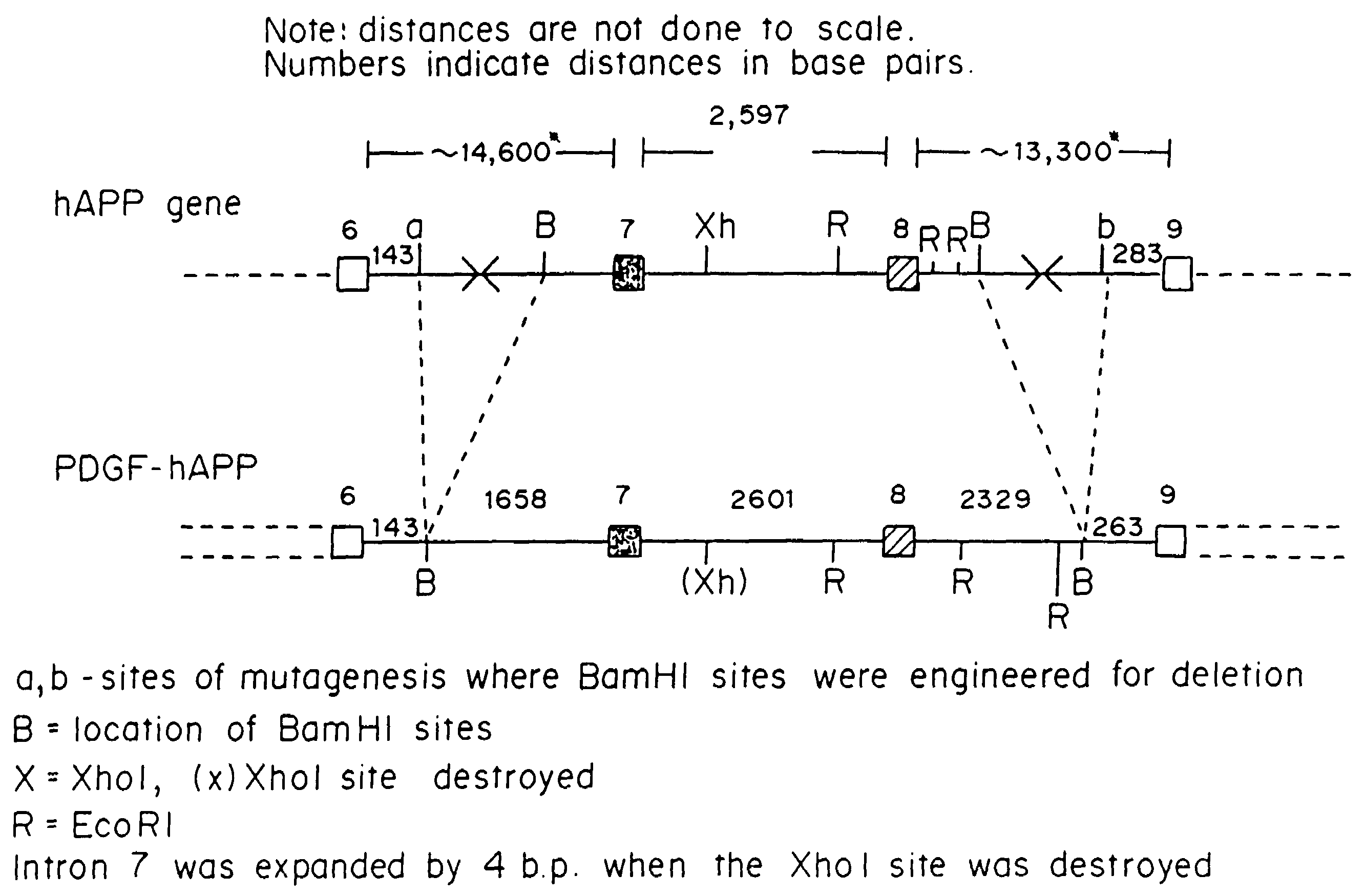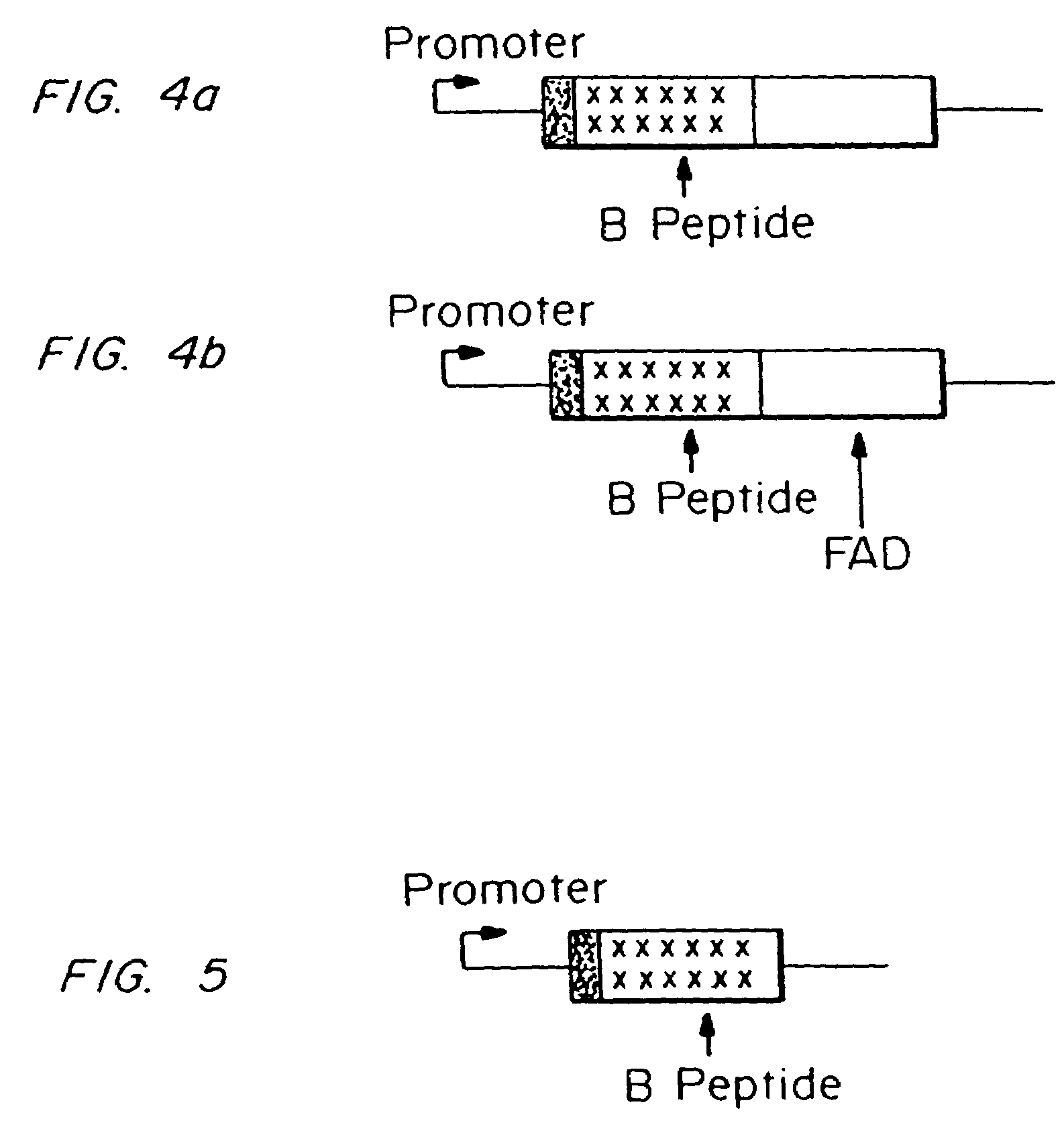Testing compounds for effects on synaptophysin in transgenic mice expressing an Alzheimer's disease FAD DNA sequence
a technology of synaptophysin and compounds, applied in the direction of peptides, peptide sources, instruments, etc., can solve the problems of memory loss, inability to function as normal individuals, and dementia in elderly peopl
- Summary
- Abstract
- Description
- Claims
- Application Information
AI Technical Summary
Benefits of technology
Problems solved by technology
Method used
Image
Examples
example 1
Expression of pMTAPP-1 in NIH373 and PC12 Cells
[0174]The clone pMTAPP-1 is an example of an APP770 expression construct as shown in FIG. 1a where the promoter used is the metallothionine promoter. Stable cell lines were derived by transfecting NIH3T3 and PC12 cell lines (ATCC #CCL92 and CRL1721). Five hundred thousand NIH3T3 or PC12 cells were plated into 100 mm dishes and transfected with a mixture of 5 mg of the SalI fragment and 1 mg of pSV2neo DNA (Southern and Berg (1982)) precipitated in the presence of 50 mg lipofectin (Gibco, BRL) in a final volume of 100 μl. Polylysine-coated plates were used for PC12 cells, which normally do not adhere well to tissue culture dishes. The cells were fed with selection medium containing 10% fetal bovine serum in DMEM or RPMI and supplemented with G418. Five hundred mg / ml (biological weight) and 250 mg / ml of G418 were used to select colonies form NIH3T3 and PC12 cells, respectively. Fifteen days after transfection, colonies of cells resistant ...
example 2
Expression of pEAPP-1 in PC12 Cells
[0176]pEAPP-1 is an example of an APP770 expression construct as shown in FIG. 1a where the promoter used is the 25 kb human APP gene promoter. DNA from this construct was transfected into PC12 cells as described above. Certain clones of pEAPP-1 transfected cells exhibited a differentiation phenotype morphologically similar to that exhibited by PC12 cells treated with nerve growth factor (NGF). PC12 cells normally are fairly round and flat cells. Those transfected with pEAPP-1 have cytoplasmic extensions resembling neurites. PC12 cells treated with NGF extend very long neuritic extensions. Thirteen PC12 cell clones transfected with pEAPP-1 were selected and propagated. Eight of these cell clones exhibited the spontaneous differentiation phenotype with clones 1-8, 1-1, and 1-4 exhibiting the strongest phenotypes. Staining of pEAPP-1 transfected PC12 cells with antibody against the Aβ as described in Example 1 indicated that those cells exhibiting th...
example 3
Expression of pMTA4 in PC12 Cells
[0177]pMTA4 is an example of the type of construct shown in FIG. 4a where the promoter used is the metallothionine promoter. The protein encoded by this construct differs slightly from that depicted in FIG. 4a. An APP770 cDNA clone was digested with Asp718 which cleaves after position 57 (number system of Kang et al. (1987)). The resulting 5′ extension was filled in using the Klenow enzyme (Sambrook et al. (1989)). The same DNA preparation was also cleaved with EcoRI which also cuts after position 2020 and the resulting 5′ extension was filled in using the Klenow enzyme (Sambrook et al. (1989)). Self-ligation of this molecule results in an expression clone in which the truncated protein thus encoded contains the leader sequence, followed by a shortened version of the Aβ starting with the sequence Phe-Arg-Val-Gly-Ser-of the Aβ followed by the 56 terminal amino acids of APP. DNA from this construct was transfected into PC12 cells as described above.
PUM
| Property | Measurement | Unit |
|---|---|---|
| Mass | aaaaa | aaaaa |
| Mass | aaaaa | aaaaa |
| Mass | aaaaa | aaaaa |
Abstract
Description
Claims
Application Information
 Login to View More
Login to View More - R&D
- Intellectual Property
- Life Sciences
- Materials
- Tech Scout
- Unparalleled Data Quality
- Higher Quality Content
- 60% Fewer Hallucinations
Browse by: Latest US Patents, China's latest patents, Technical Efficacy Thesaurus, Application Domain, Technology Topic, Popular Technical Reports.
© 2025 PatSnap. All rights reserved.Legal|Privacy policy|Modern Slavery Act Transparency Statement|Sitemap|About US| Contact US: help@patsnap.com



